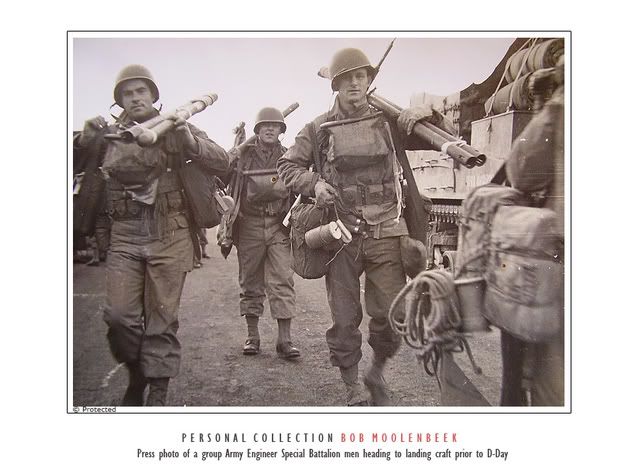Here's a list of books related to engineers and their equipment:
ENGINEERING Explosives and Demolitions
http://www.military-info.com/Aphoto/Subjectlist/A021b.htm
The Seaborne Assault
http://www.army.mil/cmh-pg/BOOKS/WWII/utah/utah3.htm
Here's an excerpt taken from the page listed above:
Clearing the Beaches
Such clearing of beach obstacles as was necessary was the mission of a special engineer force which was scheduled to land directly after the 8th Infantry. The engineer elements were organized as a Beach Obstacle Task Force, commanded by Maj. Herschel E. Linn of the 1106th Engineer Combat Group. They were to clear four 50-yard gaps in the obstacles on each beach from the high water mark seaward by hand-placed charges and tank dozers. Naval demolition teams were to destroy all obstacles under water and Army engineer teams were responsible for those above water. Army combat engineers were from the 237th Engineer Combat Battalion. The detachment of eight tank dozers was from the 612th Light Equipment Company and 70th Tank Battalion.
The plan contemplated the simultaneous landing at H plus 5 minutes of eight naval teams to clear eight s0-yard gaps in the first band of obstacles.2 This wave was to be followed in 10 minutes by 8 LCT's carrying, in addition to other tanks, 8 tank dozers. Immediately behind the tanks were to come 8 engineer combat demolition teams to clear obstacles above water. A reserve of 3 naval teams and 4 engineer teams was included in the fourth and fifth waves.
Like many other D-Day operations, this plan was not executed as conceived. Two LCT's were sunk while approaching the beach. One LCM, with an engineer demolition team, was hit by shell fire just as it lowered its ramp on Green Beach, and six men were killed. Both Army and Navy demolition teams beached almost simultaneously, together with the four reserve engineer teams which landed on Green Beach. These discrepancies between plan and performance in no case seriously hindered the operation.
The parties left the LCVP's and LCM's in three feet of water and waded ashore, each man carrying sixty pounds of explosives. Aerial photos had indicated three bands of obstacles in depth. Since H Hour was timed for a rising tide favorable for landing craft, it was expected that one band would be either in or near the edge of the water. Actually all obstacles were found dry. The Navy teams, however, proceeded as instructed to x explosives on the seaward band and the engineers moved to the next band. After the first gap at the junction of the beaches was blown, it was decided to proceed at once to the clearing of the entire beach. The landing craft heading for the initial gap were bunching so dangerously, and the obstacles were so much more sparsely distributed than expected, that the original plan of clearing only 50-yard gaps was abandoned.
Major Linn and the executive officer of the 237th Engineer Combat Battalion, Maj. R. P. Tabb, had both planned to direct operations from their M-29's (Weasels) on the beach. Major Linn's craft was sunk and Major Tabb's vehicle sank as it left the landing craft. Major Tabb saved the crew and a radio and made for the beach, where he got in touch with General Roosevelt. There was little of the expected excitement and not much confusion. Control during the landing was never a serious problem because it was decentralized. The fortuitous simultaneous landings of Army and Navy demolition teams made possible the setting and blowing of charges for all three bands of obstacles at once, and consequently saved time.
As expected, obstacles consisted mainly of steel and concrete pikes, some steel tetrahedra, and hedgehogs. Tank dozers worked effectively against some of the piling and pushed the obstacles up onto the beach, but hand-placed charges accounted for most of them. Only a few mines were found on the beach, attached to the obstacles. Belgian Gates were found in small number, a few on the beach and a few blocking the roads leading from the beach. The four reserve teams which landed on Green Beach blew these gates and assisted in blasting additional gaps in the sea wall.
The entire beach was cleared in an hour, and by that time elements of the 87th Chemical Mortar Battalion, the 3d Battalion of the 8th Infantry, and the 3d Battalion of the 22d Infantry were moving across the beaches, while engineer units were arriving to organize the beach operation. The Beach Obstacle Task Force was occupied with odd jobs for several hours more, but before noon had completed its task and reorganized. Of the 400 men involved, 6 were killed and 39 wounded.
Clearing the beach was only the first of the tasks assigned to combat engineers. One platoon of engineers was attached to each assault company of the 8th Infantry to blow gaps in the sea wall, destroy barbed wire in front and to the rear of the wall, and clear paths inland through the sand dunes. These tasks completed, they were then to perform normal assault missions against fortifications. For their initial missions they were equipped with bangalore torpedoes, mine detectors, explosives, and pioneer tools and markers. The demolition of the sea wall and clearance of paths through the sand dunes were accomplished very early. Company A, 237th Engineer Combat Battalion, blew two gaps in the wall on Red Beach, and Company C blew two on Green Beach. In addition Company A blew two Belgian Gates at the entrance to Exit 2 and picked up several prisoners from the pillboxes along the beach wall. The engineers then accompanied the infantry, removing mines and "dozing" roads across the dunes. As enemy artillery began to interdict the entrance to Exit 2, a trail was broken through the fields to the south and joined with the road which paralleled the coast and led back to Exit 2 south of la Madeleine Many of the fields back of the beach marked Miner were free, but the pattern was such that all were suspect and had to be cleared.

![]()